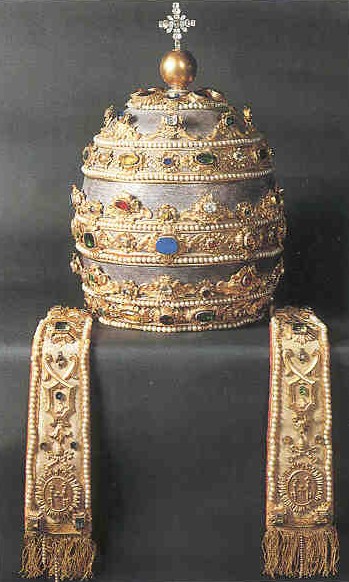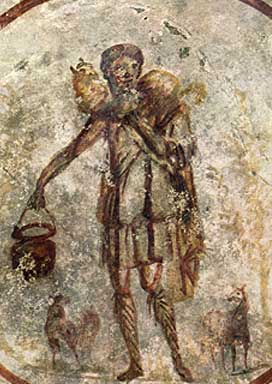Have you ever wanted to read a sci-fi novel that takes a critical look at the place of science and technology in a world populated by people stained with Sin? No? Well, read the review anyway. A Canticle for Leibowitz tells the story of the Church's decline in influence in an increasingly technological world after having preserved knowledge from the previous era of civilization after a nuclear holocaust later called the "Flame Deluge." Canticle is supposed to be science-fiction, but it takes a strong magnifying glass to the place of science and its themes, even nearly six decades after its Cold War debut, can hardly be called fiction.
Author Walter Miller, who wrote Canticle after blowing up the monastery at Monte Cassino, divided the novel into three sections which could be seen as three separate novellas, each centuries separated from the one before it. Each section, about a hundred pages, reflects the common conceptions and misconceptions about a real life time it imitates. The first section, Fiat Homo, begins six hundred years after the Flame Deluge and takes place during a new Dark Age devoid of substantial knowledge or intellectual endeavors. Reading survives as a purely functional skill rather than an intellectual tool. The story, told almost entirely from the Abbey of St. Leibowitz, has three abbots, each in turn a Catholic product of the age. The abbot during the Dark Age equivalent is very devout, very strict, and less concerned with earthly matters. The abbot in the last segment, Fiat Voluntas Tua, is certainly a good priest, but also invested in earthly cares.
Fiat Homo begins with Brother Francis, an aspiring novice with the Order of St. Albert's priory in the midwestern United States, who is in the desert fasting and praying during Lent in hope of making a solemn profession. Francis meets a feisty old man who he presumes to be a pilgrim. The pilgrim attacks Francis with his walking stick and then vanishes. Francis, dazed after the squabble, finds himself in a nuclear fallout shelter from the Flame Deluge six hundred years earlier. In it he finds a skull, some blueprints, and a scrap of paper with the name Leibowitz written on it. Leibowitz was an engineer who survived the Deluge, but lost his family. He converted to Catholicism, became a priest, and founded the Order of St Albert, a community of monks dedicated to preserving knowledge from previous times in hope that it might benefit a holier society. After the Deluge, an event called the Simplification ensued, a process of de-intellectualizing survivors and extirpating deleterious knowledge, leaving the world without information or learning. Francis' abbot meets his discovery with feigned doubt until New Rome—the old one gone—approves of the find and canonizes St Leibowitz. After the canonization a cadre of two-headed highway men, from a people genetically mutated and deformed by the nuclear holocaust, kill Francis.
Fiat Lux picks up the story centuries later when the various political entities in the region are at odds, leaving the monastery and New Rome in the middle of turmoil. "Mayor" Hannigan wishes to unite North America into one country under his rule and has taken an interest in advancing his position and his technology. Hannigan sends his cousin, Thon Taddeo, to the abbey to investigate their relics of St Leibowitz. Taddeo is the secular scholar incarnate: a blend of Einstein, a romanticized version of Newton, with a little of Voltaire's cynicism and rationalism tossed into the blender for good measure. His mild disdain for religious people is amplified when he discovers one of the monks, without any real theoretical knowledge, manages to recreate the light bulb, which the monk terms Lucifer—a play on the two meanings of the word, the devil and the morning star. Taddeo is intelligent and eager, but also hopelessly vain. He refuses to admit that the people before the Deluge were human because, as the abbot puts it—much as modern cheerleaders for scientism bifurcate the pre-Newtonian world from the post. If people from before the Flame Deluge were human then Taddeo is not a discoverer, but merely a rediscoverer. The abbot flocks to the mountain home of a hermit named Benjamin, the Wandering Jew. Benjamin insists that he is over six centuries and that he knew Brother Francis. If he is telling the truth then he might be the man Francis met in the desert, he might be St Leibowitz, or he might be both. The abbot learns that Taddeo's team is researching not only the relics of the Saint, but also the fortifications within the monastery in the event of a war. The middle segment ends with Taddeo's long elegy for the Dark Age of Fiat Homo and a new warm welcome for the age of a new Enlightenment. The Wandering Jew enters during Taddeo's speech, gazes at the scholar, and says "It's not him." Those familiar with the Wandering Jew myth will understand.
The final section, Fiat Voluntas Tua, greets the reader in a space age under the threat of nuclear war after two cities are destroyed. A U.N. equivalent hopes to stave off the inevitable while the Church makes plans to survive after earth. I will not summarize this part of the book, especially the spectacular and moving ending which can only be understood by a person of faith.
Canticle tells a recurrent history, although not one based on George Santayana's apodictic aphorism about repetition. Canticle tells our own past, present, and future without the cloudy vision of contemporary affairs, politics, and allegiances about who is right and wrong. Instead, Miller's novel narrates the reader through Sin's effort to weave its pattern in the world by tempting men through knowledge and technology while monks of God attempt to temper and tame those things, to make them befitting to a holier world. The powers of the world, be they the Green Star euthanizers of Fiat Voluntas Tua or Thon Taddeo of Fiat Lux or the highway men of Fiat Homo, ignore the Church's wisdom, her knowledge of human nature, and her patience to pursue the best thing for the world in the here and now. The last chapters capture this best, when the abbot deigns without success to convince a woman not to murder her child and herself by euthanasia. He tells them that God does not want suffering, but instead wants them to fight and to preserve the precious gift of life. The desire to better the here-and-now compels the characters outside the monastery to ignore every opportunity for a lesson and sets the stage for the denouement.
Another constant theme is the importance of knowledge. How much is enough? How much is too much? Taddeo abjures the abbot, perhaps rightly, for waiting until men are saints before introducing the abbey's collected information to the world. Could the Church ever really make men fit for the knowledge that could destroy them? If knowledge really a temptation or is it like fire, something good or bad depending on its subjective use? The process is one long temptation in man's attempt to recreate the Garden of Eden.
A Canticle for Leibowitz is well worth a read to anyone interested in the Church, in history, in science, and in ethics. Sci-fi nerds may well be disappointed. Pick up a copy.





.JPG)
.JPG)














